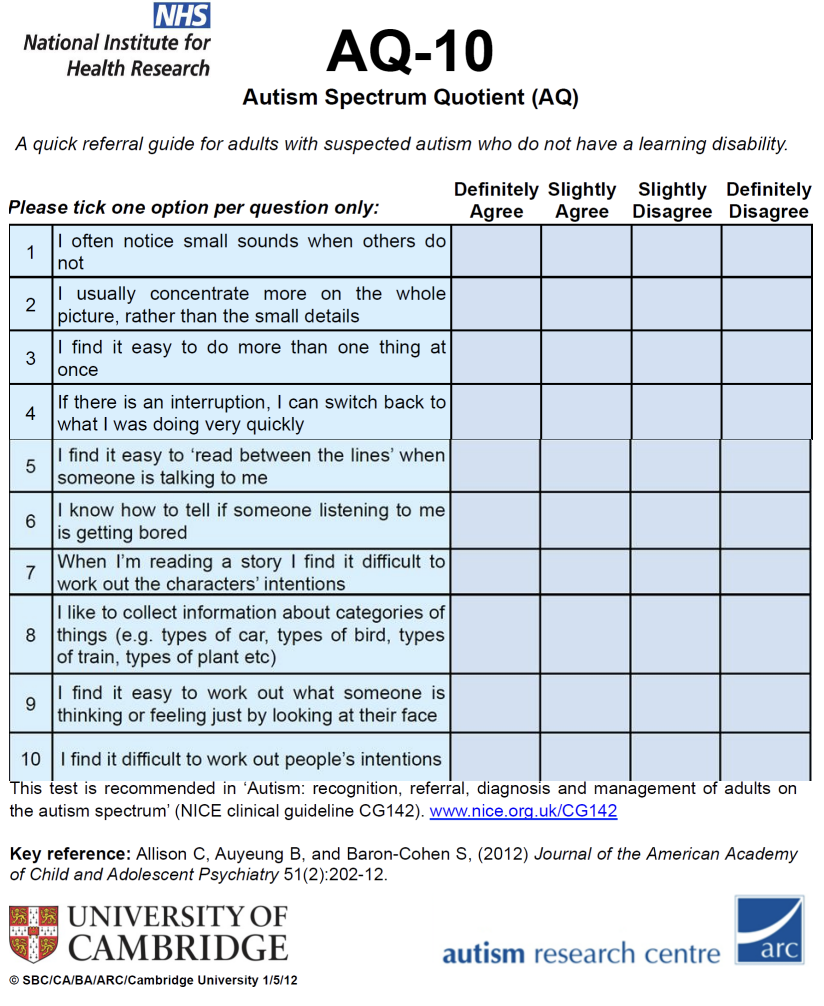Sections within this post
- Introduction
- Calling the doctors’ office
- Feeling dismissed
- The wrong referral
- ‘Right to Choose’
- Required paperwork
- The Zoom call
- The words that changed my life, forever
- The report (or lack thereof)
- Left in the dark
- Post-diagnosis - the report
- To be continued…
![]()
For my first ever series of blog posts, it made sense to start from where it all began - with autism being a lifelong and present condition and all. I was diagnosed as an adult, into my third decade - so what was life like leading up to the diagnosis moment? What signs were present without me or anybody else knowing or noticing?

Calling the doctors’ office
In August 2020, I called my doctor over a health issue. I cannot remember exactly what it was, but with how difficult it is to get an appointment with a doctor in the UK on the National Health Service (NHS) due to unrelenting demand, and also during a pandemic, it was vital that I had a number of ailments cued up to fire away at the doctor whilst I had some allotted time with them.
Getting a doctor’s appointment is the first step in getting a diagnosis, pretty much for anything, in the UK. After discussing the other ailments, I took in a deep breath, and felt a pang of anxiety.
“Sorry, I know we’ve talked about things already and we are meant to only stick to one topic per appointment… but there’s something else I wanted to ask about… I think I might be autistic.”
Feeling dismissed
There was no turning back, the words had come out. Somehow, I felt like I was revealing a deep, dark secret into the wide open. I was telling a stranger something deeply personal about myself, that may not even be true. The months of research leading up to this appointment and admission ended in a crescendo. My anxiety peaked once the words had been said… and my mood quickly changed as the doctor responded to my ‘claim’.
“Hmm… I think everyone is a little bit autistic.”
After this typical, cliche response, I nervously quickfired a load of my ‘little quirks’ that alluded to potential autism, including my absolute visceral hatred of people touching or moving my things. The quickfire backfired:
“My kids move my things all the time and it annoys me, but I just get on with it.”
Talk about playing it down. I cannot remember exactly what my response was to this, but I felt the need to become defensive, to persist and get what I wanted, despite feeling completely humiliated and downtrodden - I wanted a referral for diagnosis. What the doctor said above got to me (and I did complain, which I will get to later), but it was clear that my response to my stuff being moved went beyond ‘just get on with it’ - it often meant a meltdown was inbound.
One thing I have noticed about doctors in the UK is that they like to ask you ‘what you want’ - which really confuses me. Surely, as the doctor, you are the one to tell me how to resolve the problem I have come to you with. The doctor indeed just asked me ‘what I wanted’. I was reluctantly put down to be referred for an autism assessment, and was sent on my way with an adult AQ10 questionnaire to complete.

(Apologies if this is hard to read - may be more legible on zoom in)
This was standard practice for kicking off the autism assessment referral, and was to be done by myself and sent back to the doctors’ office. It was the first step in telling the doctor that ‘I should be considered for an autism assessment’, as whilst whatever I said was dismissed in the appointment, the document was their first ‘proof’ that an assessment should be considered.
The wrong referral
And so after the doctors’ appointment and submission of the AQ10 document, the waiting started. There were no updates or anything, for nearly a year. A letter landed on the doormat for me from a diagnostic service around 11 months later, saying that they ‘no longer offer ADHD assessments’ in my area. I was so dismissed about being autistic that the doctor had referred me to be tested for the wrong condition (I am joking here).
I absolutely hate any level of conflict or putting people out, but in this instance I felt the need to send a formal written complaint to my doctor’s office, for the wrong referral costing so much waiting time, and the initial dismissal of my potential autism by the doctor I spoke to to start the diagnostic process. I got a measely ‘sorry for the inconvenience’ for both of these.
‘Right to Choose’
I had heard about a scheme in the UK, called ‘Right to Choose’, mainly for ADHD assessments. This allows you to request where you are referred to, for example, a particular clinic or service providing the diagnosis you are looking for. Upon my research into autism diagnosis, I learned that it is possible to use Right to Choose for autism assessments.
Another plus side to this was that, at the time I was seeking diagnosis, it was a way to ‘speed up’ your referral. I didn’t have any preference for where was to test and diagnose me, but my impatience meant I would do anything to reduce the wait (besides going private - some support services require NHS diagnosis in the UK). Of course, it was back to square one anyway after being referred for the wrong condition.
To enact the Right to Choose, I used a template letter I found on a UK psychological diagnostic service’s website, changed it to suit my needs (e.g. I was writing about autism, not ADHD) and sent it to my doctors’ office.
Required paperwork
About half a year after sending the Right to Choose letter, I started calling the doctors’ office to chase up where my referral was at. News was very little, and another hurdle was hit in that a service I was being referred to was no longer able to take me on for diagnosis. I finally got referred to a company that served NHS patients as well as those going private.
It was early spring in 2022 when I started to get paperwork through. The initial step was to confirm all my details. After that, it was another couple of months of waiting, until summer of 2022, when I got a chunk of paperwork through to complete. This included the AQ50, the Empathy Quotient and a questionnaire for someone who had known me since childhood (i.e., a parent or equivalent).
I didn’t rush through the documents, but made sure to complete them as fast as possible, so that the wait would be back with the diagnostic service and not from me being lazy. Once done and submitted in July 2022, it was early September 2022 when I was sent a 2-hour appointment for the end of September, to be assessed via a one-to-one conversation. This was to be done over Zoom.
The Zoom call
As of the time being 2022, we were still going through that pandemic, and so the diagnostic service was still doing their assessments over Zoom / telephone. This was a blessing in not having to arrange or conduct any travel plans, but at the same time, I wondered how effective it would be in them diagnosing me when all they have is my word over the line. On top of this, having my webcam on was optional, and I never have the camera on me for meetings in general as I cannot focus on the task at hand when it is on. I made a special exception as I hoped them being able to witness my body language would help in conducting the assessment - but it didn’t half drain me.
For the assessment, my assessor was younger than me, but very friendly and calming, which of course helped me to open up and do my oversharing spiel. The process was that she would run through the AQ50 with me, get me to respond with to what extent I agree with each question in the test, and the reasoning for why I agree / disagree. The open-endedness of the reasoning meant I waffled on and on trying to prove myself and convince this stranger that I am autistic, causing the appointment to go over the allotted 2-hour timeslot. Even then, she had to prompt me to move on or we wouldn’t get through everything. I even rocked up with my 30-page document as to ‘why I think I’m autistic’, all the examples throughout my life that made me come to the conclusion, but it was never used at any point of my assessment.
Interestingly, there were ‘newer’ questions being asked of me that I hadn’t seen in any AQ50 samples before - I cannot remember if these were as part of the updated assessment criteria or if they were simply an aide for the diagnostic service to come to their conclusion on my possible autism. They were based on my sleeping habits - how sensitive I was to external stimulus (the answer is very, I need earplugs and sometimes an eyemask), if I had a regular sleep schedule (I try but sporadic terminal insomnia is really irritating) and the depth of sleep that I tended to get (I have spells of lucid dreaming).
Before the call ended, I was informed that my responses to the questions / prompts were to be taken away and reviewed by not just my assessor, but three others, in order to come to a solid consensus about me being autistic or not.
The words that changed my life, forever
After the Zoom assessment, I sat in a patient state of limbo, waiting to hear about the outcome. I was used to waiting a while and could not be bothered to do any more chasing. And then, out of the blue, about 3-4 weeks after the Zoom assessment, I got a phone call from the diagnostic service. Luckily, I was sat down at the time.
Once the usual small talk pleasantries were over, the words came thick and fast:
“After our thorough assessment process and review by peers, we have come to the conclusion that you have a diagnosis of Autism Spectrum Disorder / Condition”.
A weird seeping feeling came over me, the sort that you get when you are told a life-altering fact (such as, someone is unexpectedly pregnant, getting married, or has passed on). A sense of relief and “oh, wow” came next. Finally, an answer for whatever that is and why I’m that way in that situation. After all that research and waiting, I wasn’t imagining things at all. It was like a movie started playing in my head - all the past that I had to dredge up as part of the diagnostic process started re-rolling. All those awkward, upsetting experiences replaying yet again, but through a whole new lens.
The report (or lack thereof)
(When writing this blog post, I had planned to write this section going into detail of the report itself, but I feel like it deserves its own post. It would probably make this post far too long by including it here.)
Whilst I had received the diagnosis over the phone, I was to also receive it in writing, and so was my doctors’ office. Of course, this involved more waiting around. Although the postal service in my area is quite slow at the best of times, it was about another month’s worth of waiting for the report to come through to me.
The report was a stack of paper - 16 pages in length. It covered everything that was discussed in the Zoom call, bookended by information on autism itself, and what comes next after diagnosis. It was an in-depth justification as to why they had come to the conclusion that I am on the spectrum.
As told over the phone and within the report itself, my doctors’ office was to receive a short version of the report confirming my diagnosis. However, in recent times where I have needed proof of autism from my doctor for something, I’ve been unable to get it with ease as there is zero trace of my autism diagnosis on my health records. That means they either never receieved the short report, or it was never recorded on their systems. It feels as though the only proof I have of being autistic is the presentation folder holding the 16 page report (one physical copy, which I’ve since digitised in case).
Left in the dark
Despite receiving the report which included promises of follow-ups, the ability to get support and so on, I have pretty much received absolutely nothing in those regards and have been left to act independently upon receiving the diagnosis. It was all on me to decide who to tell, and what to do about it - and to process my feelings about it. I still don’t really know what support I am entitled to.
Whilst relieving, it also felt quite isolating having the diagnosis with none of those around me having an understanding of it anywhere near as close to mine after so much researching about it. It all felt very “you’re on your own, kid” after. Like entering a void of “now what?”.

Post-diagnosis - the report
With brief mentions of the mammoth 16-pager diagnostic report in this post, for the next one, I will be deep-diving into the report itself - pulling out direct quotations, providing commentary on points in the report, and so on.
Thank you very much for reading this blog post. I appreciate you spending time here on my corner of the internet. Hopefully you got something out of reading the essay above.
Stay tuned for the next part in the series and be the first to read it by following me on the social media links, in the menu bar, to know exactly when new posts are published.

Until next time,

